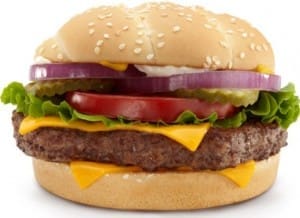THERE’s plenty of potential for beef producers and McDonald’s to work together to bridge the gap between beef production and consumer expectations, one of the company’s senior supply chain executives says.
Delivering a presentation at a JBS producer gathering in Melbourne recently was Andrew Brazier, McDonald’s worldwide supply chain management director.
Based in Chicago, Mr Brazier is an expat Aussie, having been born and raised in central western NSW, where his family still operates a mixed farming/grazing operation.
An agribusiness graduate from the University of Western Sydney, he spent years as a meat trader. His next move was helping build a purpose built company to consolidate and supply beef raw material supply from Australia and New Zealand to the system, before joining the burger restaurant giant. He was appointed to his current position 15 months ago.
“As a commodity trader, I loved volatility. As long as markets were moving up or down, I was happy, because it provided opportunity to turn a buck,” he told the producer gathering.
But it was only after moving from meat trading to McDonald’s that he started to gain real insight into meeting customer expectations. Today, he effectively sits at the interface between beef producers whose product is used by McDonald’s, and that ‘moment of truth’ when the product goes over the counter to the consumer.
“Today, there’s a gap emerging between the great taste of our product (beef) that consumers clearly identify with, and the trust that they have in our industry,” Mr Brazier told the Melbourne gathering.
“Contrary to some of the mis-information that’s out there, we know that beef is beneficial to us – it’s healthy, and tastes great. The challenge is the disconnect between consumers who do not really know that much about beef – where it comes from, how it was raised, and those related aspects that beef farmers really care about.”
“I see that as a big opportunity for us (McDonald’s, and the broader beef supply chain) to help tell that story. And equally, it represents an opportunity for the industry, collectively, to sell more beef,” he said.
Putting the McDonald’s business into some context, he said the company currently serves around 70 million people worldwide every day, through 36,000 restaurants in 119 countries. Those outlets serve more than two billion beef-based burgers each year, and the annual ‘butcher’s bill’ to meet the demand is over US$4 billion.
“Those figures illustrate that consumers love our brand, they love the way our food tastes,” Mr Brazier said.
“But it all starts at the farm – your farm. More and more, customers are asking us: is the food you serve good quality; where does the beef come from; what else is in it; is it healthy; does the business have a negative impact on my family or the environment?”
Part of the reason for questions like these, and the general level of trust that consumers had in the beef industry, was a lack of understanding and education.
Mr Brazier said in the US, 30pc of ‘millennials’ aged 18-35 had never been on a farm. In the UK, 50pc of adults under 25 years did not know that bacon comes from pork.
“With the increasing trend towards urbanisation, consumers’ understanding of where food comes from is only going to continue to decline. This results in a gap between the ‘taste’ and the ‘trust’, which potentially can impact not only on beef sales at McDonald’s, but also for the global beef industry at large.”
“The reality is that Australian beef now goes right around the world, so trends like these, even on the other side of the globe, directly affect you,” he told the Melbourne forum.
But equally, McDonald’s thinks it has some answers, based around its numerous ‘customer-facing’ brands and deep market penetration.
With 70 million customers each day and a substantial global advertising budget, we have a powerful reach to be able to tell a story, and a massive audience to tell it to
“With 70 million customers each day and a substantial global advertising budget, we have a powerful reach to be able to tell a story, and a massive audience to tell it to,” Mr Brazier said.
“We’re in a unique position to hear, feel and react to what customers today want from a company like ours, and an industry like beef.”
Consumers today were ‘more different’ than at any other time in history, he said.
“In the past few years we have seen a major shift in consumer behaviour, enabled by digital and mobile device technology. Consumers think differently and express themselves differently, because of that technology.”
“They expect their opinions to matter, and they do. Customers used to be limited in how they were able to buy, by simply walking into the local store. Now, online retailing means a consumer can buy almost anything online, from anywhere. Consumers have more choice, more options, and exposure to more ideas than at any other time in history.”
Because of this, McDonald’s believes it has to interact with customers differently.
Today’s consumes get ideas and form opinions through social media. They are no longer confined by physical location or geographical boundaries. Technology is allowing consumers to have a much more powerful voice, and an active influence on products through global social networks.
“It has created a consumer culture that demands transparency from the companies and the brands from which they are buying,” Mr Brazier said.
“Consumers increasingly want to align themselves with brands that reflect their own value-system – and equally, distance themselves from those that do not,” he said.
Targeting ‘Digital natives’
McDonald’s saw its most influential consumers as the so-called ‘digital natives’ – those consumers 18-35 years of age who have lived with computer technology their whole life.
They tended to be more health-conscious that the older generations, and half of US consumers aged 18-35 agreed that the brands they choose to buy said something about who they are, and the values they hold.
“These are the people who we are selling our beef – your beef – to, all over the world, and they are the people we need to be listening to,” Mr Brazier said.
But the ‘digital natives’ did not necessarily appreciate the care that’s been taken on cattle farms or properties.
“They don’t understand how cattle are raised or what they have been fed. They don’t know your story,” he said.
This lack of sharing of information has meant McDonald’s has seen a shift in its definition of quality, as it relates to beef.
The old definition served us well for decades, but it’s no longer in sync with customer expectations
“The old definition served us well for decades, but it’s no longer in sync with customer expectations,” Mr Brazier said.
He illustrated this with a series of headlines from around the world that some customers often believed: suggesting that beef production meant ‘inhumane treatment of animals’; that it depletes natural resources; that it negatively impacts on the environment; and that vegetarian diets are more healthy.
 “These are the sort of messages that we, collectively, need to address, in order to raise the bar over how we communicate with consumers about what’s going on – so that consumers are more comfortable, and more confident, in eating the food that we produce,” he said.
“These are the sort of messages that we, collectively, need to address, in order to raise the bar over how we communicate with consumers about what’s going on – so that consumers are more comfortable, and more confident, in eating the food that we produce,” he said.
“If we can change this collectively, then it becomes a very powerful message.”
McDonald’s was addressing this customer expectation challenge by ‘listening more, and assuming less’, and ‘asking more questions and getting lots of answers back.’
The company is now actively engaged in social media discussion across many parts of the world about what’s happening with its brands, and beef production.
“We want consumers to know what we are doing, and that we care about the same things that they care about. If we can win people over with the strong story we are able to tell them, they’re likely to become advocates for us, and the beef industry as well.”
“Consumers really want to hear real stories from real people. Stories from farmers about the hard work and care that goes into the land to produce a quality product. Stories about the family businesses that passes down through the generations, where the land is left as good, if not better, for each subsequent generation to manage.”
“And stories about an industry that genuinely cares about doing the right thing, and continual improvement – producing ‘honest’ food that consumers can feel good about eating.”
See this morning’s separate story on how McDonald’s is approaching the ‘sustainability challenge.’
See this morning’s separate story on how McDonald’s is approaching the ‘sustainability challenge.’



